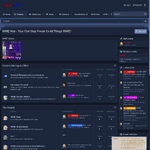One of my previous web design clients really loved to get into the weeds. My first assignment for them was to design a logo for their website and newsletter. Their first task to another contractor: get a prototype website up. What happened to the logo? It got scrapped. What happened to that website? It joined the ranks of moderately ineffective websites that basically does nothing. In fact, they had an entire separate website that did what they wanted already!
During that job, I was forced by my rampaging emotions of rage and pain to codify how web design and websites work. After doing two community college degrees in web design and development and years of independent study on the subject, I came to an understanding of the four pillars of web design:

1. Programming: The nuts and bolts of how your website runs. This could be a programming language like JavaScript or PHP, or it could be a framework like Wordpress or Xenforo. Or it could be both. Template websites, plugins, programming languages, frameworks, engines, and A.I. all belong in this category. To get better at this, get a computer science degree, a coding bootcamp, and learn how to use Linux and Node.js.
2. Design: This is the stuff you do in Adobe Photoshop, Illustrator, and MSPaint (if you're me ). This is your CSS3, your SCSS, and your SASS. This is the cheap discount Wordpress theme you bought for 5 bucks that has nothing to do with the subject of your site (yes, I saw you do that, and now you are trying to reprogram it even though you don't know anything about CSS). Bad humor aside, this is the theme of your website and how your website looks to your visitors. It's your text font and color, how the containers are arranged on your page, and whether that div is actually centered.
). This is your CSS3, your SCSS, and your SASS. This is the cheap discount Wordpress theme you bought for 5 bucks that has nothing to do with the subject of your site (yes, I saw you do that, and now you are trying to reprogram it even though you don't know anything about CSS). Bad humor aside, this is the theme of your website and how your website looks to your visitors. It's your text font and color, how the containers are arranged on your page, and whether that div is actually centered.
To get better at design, get some classes in CSS, SCSS, and learn how to use Photoshop and Illustrator. You may also want to become familiar with Adobe Dreamweaver and a little subscription tool called Figma. Research UI/UX design.
3. Marketing: All good websites are marketing something. If you aren't marketing something, you're not making any money, and if you're not making any money, your site won't be up for very long. Websites cost money to maintain and thus need to be making money from their userbase to make up the difference. Also, good websites cost money and time and effort to build and maintain, and thus the owner deserves to be compensated for their efforts.
Marketing consists of a product or service that the owner of the website wants their users to buy in order to compensate the site owner(s). This can take the form of ads (in which case the product is somewhere else) or a product the owner is selling. The owner may also offer premium services on the site on behalf of users (unlimited private messaging, for example) for a price.
To get better at marketing, take classes in business and marketing. These are available from community colleges and also from private internet marketing companies as certifications. Hubspot is a source of information and quality articles on the subject.
4. Writing/Content: This is the text on your site that Google and other search engines will read. All websites, including YouTube, have some text on each webpage to specify what a specific article or video is about. Otherwise, search engine spiders will not understand your site. Common sources of text include video titles, blog posts and articles, and forum posts.
To improve your writing skills, you can take a writing class, but you also need experience writing for the web. A Search Engine Optimization class and A.I. that optimize your writing for search will do more for you than writing an essay on Romantic Literature. Colleges sadly aren't up to speed, unless you want to optimize poetry. And if you want to do that, call me for a collaboration. I'm in.
But how does all of this work? Why do I need all of this?
Because without this, you're not making any money and you're broke. Sure, you can put up an ugly website that barely works and markets nothing with no content, but now you're paying $30 a month for nothing. In order to influence human beings to action, it pays to get a handle on how human beings make decisions, including the one to sign up for your forum or buy your product.

In order to buy something, a human being has to know that your product exists (information), believe that it is a good product that solves a problem they have (beliefs), feel that making the purchase is a good idea, and then they will buy it. If the product or service is good, they will become a repeat customer, identifying with your brand and not buying products from competitors in favor of your product.
For example, consider the website that we are at right now. At Bizdustry, this site is about making money online. An internet user needs to be aware that this site exists, then they need to believe that making money online is a good idea and it's something they want more information on. Then they need to feel that it's something they want to invest in, enough to hit the register button and create a new account. This action puts you on the path to being someone who makes money online. This is your community and thus your identity now. You're in the online camp (as opposed to the offline earners). You're supporting the online money-makers.
But let's take this a step further: this site is supported by advertising, so the action this site wants you to take is to click on an ad here. The signing up for an account is just a prelude to the action of an ad click. The more you browse this site, the more likely you will find an ad you like. Even if you never click on an ad, however, you are attracting more people with your content who might click on an ad. The quality of advertising here is what is being sold.
By contrast, let's take a more straightforward example: a company that sells belts that hold up pants. How does a website directly influence the purchase of a belt?
It is now that I may make a small confession of a trick: there are five pillars of web design instead of four. But not really, because your product and your people are elements of your business, not your website per se. The whole diagram above me is marketing, in case you were wondering where that went. It capitalizes on the human desire for mystery and intrigue, to understand the unknown. Web designers sell information about the unknown for a price. But so do product designers. The parallel leads to monetary opportunities.
For our belt, it all starts with content - from social media or a search engine - that our customer runs across about the belt. This is information. This is what inspires the customer to go to our website, where he or she gets writing - information about the belt, pictures of it, and so on. This leads him or her to believe that the belt is a good product.
But, it doesn't matter how good the belt is if the website is poorly designed. If the website is in Times New Roman with nary a functional menu or a strand of CSS code applied, our customer will think that our business is a scam. The business needs to present itself well or the customer will get a bad feeling about the business and decide to go elsewhere for his or her belt purchase.
Finally, the website needs to function properly, which is a function of the programming that went into the site. If the shopping cart breaks or there is a bug in the site that prevents the customer from buying the belt, he or she will not be able to buy a belt from us. Actions are a function of how well the site is coded in.
And then, whether the customer comes back is a function of the quality of the belt and how well it holds up over time.
But I have multiple products...
Then it comes down to individual pages for each one. You need to design the influence process for each product and tailor your messages to your audience over time. The operating question at any given moment for any given site is this "What do I want my users to DO?"
If my clients at the beginning of the article had really considered that question, they would have realized that they wanted poets to enter their writing contest and pay an entry fee. They might have also realized that their other website was more equipped for the task. The website they wanted me to optimize was an archive of previous issues of the journal. Had we realized that was the focal point, we could have discussed ways to make that more intriguing and to monetize the archive. But you know, their loss.
During that job, I was forced by my rampaging emotions of rage and pain to codify how web design and websites work. After doing two community college degrees in web design and development and years of independent study on the subject, I came to an understanding of the four pillars of web design:

1. Programming: The nuts and bolts of how your website runs. This could be a programming language like JavaScript or PHP, or it could be a framework like Wordpress or Xenforo. Or it could be both. Template websites, plugins, programming languages, frameworks, engines, and A.I. all belong in this category. To get better at this, get a computer science degree, a coding bootcamp, and learn how to use Linux and Node.js.
2. Design: This is the stuff you do in Adobe Photoshop, Illustrator, and MSPaint (if you're me
To get better at design, get some classes in CSS, SCSS, and learn how to use Photoshop and Illustrator. You may also want to become familiar with Adobe Dreamweaver and a little subscription tool called Figma. Research UI/UX design.
3. Marketing: All good websites are marketing something. If you aren't marketing something, you're not making any money, and if you're not making any money, your site won't be up for very long. Websites cost money to maintain and thus need to be making money from their userbase to make up the difference. Also, good websites cost money and time and effort to build and maintain, and thus the owner deserves to be compensated for their efforts.
Marketing consists of a product or service that the owner of the website wants their users to buy in order to compensate the site owner(s). This can take the form of ads (in which case the product is somewhere else) or a product the owner is selling. The owner may also offer premium services on the site on behalf of users (unlimited private messaging, for example) for a price.
To get better at marketing, take classes in business and marketing. These are available from community colleges and also from private internet marketing companies as certifications. Hubspot is a source of information and quality articles on the subject.
4. Writing/Content: This is the text on your site that Google and other search engines will read. All websites, including YouTube, have some text on each webpage to specify what a specific article or video is about. Otherwise, search engine spiders will not understand your site. Common sources of text include video titles, blog posts and articles, and forum posts.
To improve your writing skills, you can take a writing class, but you also need experience writing for the web. A Search Engine Optimization class and A.I. that optimize your writing for search will do more for you than writing an essay on Romantic Literature. Colleges sadly aren't up to speed, unless you want to optimize poetry. And if you want to do that, call me for a collaboration. I'm in.
But how does all of this work? Why do I need all of this?
Because without this, you're not making any money and you're broke. Sure, you can put up an ugly website that barely works and markets nothing with no content, but now you're paying $30 a month for nothing. In order to influence human beings to action, it pays to get a handle on how human beings make decisions, including the one to sign up for your forum or buy your product.

In order to buy something, a human being has to know that your product exists (information), believe that it is a good product that solves a problem they have (beliefs), feel that making the purchase is a good idea, and then they will buy it. If the product or service is good, they will become a repeat customer, identifying with your brand and not buying products from competitors in favor of your product.
For example, consider the website that we are at right now. At Bizdustry, this site is about making money online. An internet user needs to be aware that this site exists, then they need to believe that making money online is a good idea and it's something they want more information on. Then they need to feel that it's something they want to invest in, enough to hit the register button and create a new account. This action puts you on the path to being someone who makes money online. This is your community and thus your identity now. You're in the online camp (as opposed to the offline earners). You're supporting the online money-makers.
But let's take this a step further: this site is supported by advertising, so the action this site wants you to take is to click on an ad here. The signing up for an account is just a prelude to the action of an ad click. The more you browse this site, the more likely you will find an ad you like. Even if you never click on an ad, however, you are attracting more people with your content who might click on an ad. The quality of advertising here is what is being sold.
By contrast, let's take a more straightforward example: a company that sells belts that hold up pants. How does a website directly influence the purchase of a belt?

It is now that I may make a small confession of a trick: there are five pillars of web design instead of four. But not really, because your product and your people are elements of your business, not your website per se. The whole diagram above me is marketing, in case you were wondering where that went. It capitalizes on the human desire for mystery and intrigue, to understand the unknown. Web designers sell information about the unknown for a price. But so do product designers. The parallel leads to monetary opportunities.
For our belt, it all starts with content - from social media or a search engine - that our customer runs across about the belt. This is information. This is what inspires the customer to go to our website, where he or she gets writing - information about the belt, pictures of it, and so on. This leads him or her to believe that the belt is a good product.
But, it doesn't matter how good the belt is if the website is poorly designed. If the website is in Times New Roman with nary a functional menu or a strand of CSS code applied, our customer will think that our business is a scam. The business needs to present itself well or the customer will get a bad feeling about the business and decide to go elsewhere for his or her belt purchase.
Finally, the website needs to function properly, which is a function of the programming that went into the site. If the shopping cart breaks or there is a bug in the site that prevents the customer from buying the belt, he or she will not be able to buy a belt from us. Actions are a function of how well the site is coded in.
And then, whether the customer comes back is a function of the quality of the belt and how well it holds up over time.
But I have multiple products...
Then it comes down to individual pages for each one. You need to design the influence process for each product and tailor your messages to your audience over time. The operating question at any given moment for any given site is this "What do I want my users to DO?"
If my clients at the beginning of the article had really considered that question, they would have realized that they wanted poets to enter their writing contest and pay an entry fee. They might have also realized that their other website was more equipped for the task. The website they wanted me to optimize was an archive of previous issues of the journal. Had we realized that was the focal point, we could have discussed ways to make that more intriguing and to monetize the archive. But you know, their loss.



